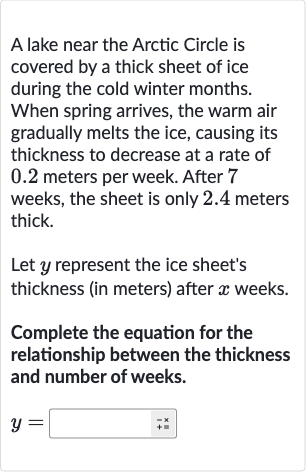AI tutor
Welcome to Bytelearn!
Let’s check out your problem:

A lake near the Arctic Circle is covered by a thick sheet of ice during the cold winter months. When spring arrives, the warm air gradually melts the ice, causing its thickness to decrease at a rate of . meters per week. After weeks, the sheet is only . meters thick.Let represent the ice sheet's thickness (in meters) after weeks.Complete the equation for the relationship between the thickness and number of weeks.
Full solution
Q. A lake near the Arctic Circle is covered by a thick sheet of ice during the cold winter months. When spring arrives, the warm air gradually melts the ice, causing its thickness to decrease at a rate of . meters per week. After weeks, the sheet is only . meters thick.Let represent the ice sheet's thickness (in meters) after weeks.Complete the equation for the relationship between the thickness and number of weeks.
- Determine Initial Thickness: To find the equation that represents the relationship between the ice sheet's thickness () and the number of weeks (), we need to determine the starting thickness of the ice before it began to melt. We know that the ice thickness decreases by meters per week, and after weeks, it is meters thick.
- Calculate Total Decrease: We can calculate the initial thickness by adding the total decrease in thickness over weeks to the final thickness. The total decrease is weeks times meters per week.Total decrease = weeks meters/week = meters.
- Find Initial Thickness: Now, we add the total decrease to the final thickness to find the initial thickness.Initial thickness = Final thickness + Total decrease = meters + meters = meters.
- Write Equation: With the initial thickness found, we can write the equation that represents the relationship between the thickness and the number of weeks . Since the thickness decreases by meters each week, the equation is:
More problems from Write exponential functions: word problems
QuestionGet tutor help
QuestionGet tutor help
QuestionGet tutor help
QuestionGet tutor help
QuestionGet tutor help
QuestionGet tutor help
QuestionGet tutor help
QuestionGet tutor help
QuestionGet tutor help
